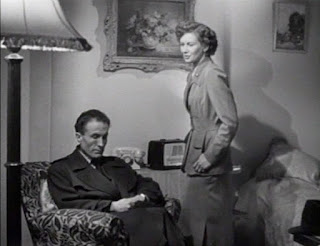John Gilling was a talented British writer-director who had a fairly successful career in the 50s and 60s before giving up movies to concentrate on painting. No Trace is one of his early efforts and it’s a reasonably entertaining crime thriller.
This is more of an inverted detective story than a murder mystery. We know the criminal’s identity almost from the start so the emphasis is on suspense rather than mystery.
Robert Southley (Hugh Sinclair) is a successful crime novelist. He has always been rather dismissive of the crime-solving abilities of the police while his friend Inspector MacDougall (John Laurie) has been equally scornful of the efforts of amateurs like crime writers who think they could a better job than a trained professional. MacDougall has often challenged Southley to accompany him on an investigation so he can se how a real detective gets the job done. Now they are about to have an unexpected opportunity to match wits.
It should be explained that No Trace is not just the title of the movie but also the title of one of Southley’s own crime thrillers. In this film real life events will run in parallel to the plot of Southley’s current book.
Southley’s secretary Linda will also have a chance to try her hand at being a detective, and will discover that it can be a dangerous pastime.
One of the reasons Southley has been so successful as a crime writer is that he knows crime from the inside, having been a member of a notorious criminal gang in the United States when he was younger. Now that he’s a successful and respected British novelist he’s not anxious for anyone to know about his past misdeeds. This leaves him open to blackmail should any of his past accomplices suddenly show up, which is of course exactly what happens. Southley has no intention of allowing a blackmailer to disrupt his very comfortable existence and his very successful new career.
Hugh Sinclair is quite solid as Southley. He’s convincing as the respectable novelist but the ruthlessness of the tough guy Southley had once been been is clearly still there under the surface. Dinah Sheridan is unfortunately rather bland as his secretary Linda. Barry Morse is very good as Linda’s boyfriend Detective-Sergeant John Harrison, and the tension between Southley and Harrison is quite effective.
The real acting highlight though is John Laurie’s performance as Inspector MacDougall. Laurie is best remembered as Private Frazer in Dad’s Army but he had been a fine and very prolific character actor. No Trace gives him a rare and welcome chance to play a substantial rôle and he makes the most of it.
It would be an exaggeration to describe this movie as true film noir but it does have its darker moments and the theme of a man unable to escape his past does at least give it an affinity with noir, and there are occasional visual touches that are perhaps slightly noir.
Writer-director John Gilling’s career was rather varied but most of his movies are worth a look. He made several fine movies for Hammer including the excellent gothic horror chiller The Reptile. He was also responsible for The Challenge, a rather good British film noir staring Jayne Mansfield of all people. No Trace doesn’t give him a huge amount of scope for doing anything fancy but he does a very competent job and he does throw in a few rather nice touches.
The movie was produced by Robert S. Baker and Monty Berman who later went on to become very important producers in the golden age of British television.
The Region 2 DVD from Simply Media is a little disappointing. Image quality is acceptable if decidedly less than stunning but sound quality is definitely a bit of a problem. It’s crackly and you’ll need to turn the volume up quite a bit to avoid missing the dialogue. Of course it’s highly probable that the problem originates in the state of the source print and Simply Media may well have done the best they could (and they’re to be commended for making interesting obscurities like this one available at all). It’s quite watchable though and the slight sound problems don’t really detract from enjoyment of the film.
No Trace is a decent low-budget crime thriller that never reaches any great heights but it’s enjoyable enough. Recommended, although given the slightly iffy quality of the DVD and the fact that it’s just a little pricey it might be a better prospect for a rental than a purchase.































